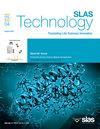HTS library plate rejuvenation using a DMSO-rich atmosphere
IF 2.5
4区 医学
Q3 BIOCHEMICAL RESEARCH METHODS
引用次数: 0
Abstract
Dry DMSO can rapidly pull water vapor out of the air due to its hygroscopic nature. This is a well-documented problem within drug discovery, particularly within high-throughput screening (HTS). This hydration is caused by atmospheric moisture being absorbed each time a compound library is used. This effect becomes increasingly pronounced when a compound library is used routinely. The result of this hydration is a change to both the total volume of solution and the concentration of sample still in solution. This can result in a large amount of variability in the measured biological activity of a sample depending on the library usage. In this paper, we show the detrimental effects the hydration of sample libraries has on the reproducibility of biological data and present a novel way to remove it from HTS library plates. Our approach involves creating a DMSO-rich environment, created by placing anhydrous DMSO in compound storage pods purged with nitrogen, and incubating library plates in this environment for up to 3 days. Quantification via evaporative light scattering detection (ELSD) showed that removing water greatly increased the molarity of solutions, with a greater effect being seen for compounds with poor solubility. We also demonstrated how this approach can restore the inhibitory activity of stock solutions of compounds (pIC50) of samples containing ∼30 % water from >30 µM to sub-micromolar after moisture removal. This method improves the reliability of tested compounds in HTS by potentially saving pharmaceutical companies hundreds of thousands of dollars in screening campaigns and increasing the quality of data.

使用富含二甲基亚砜的气氛使 HTS 库板恢复活力。
由于具有吸湿性,干燥的二甲基亚砜能迅速从空气中吸附水蒸气。这是药物发现领域,尤其是高通量筛选(HTS)领域一个有据可查的问题。每次使用化合物库时,大气中的水分都会被吸收,从而导致这种水化现象。当化合物库被常规使用时,这种影响会变得越来越明显。水化的结果是改变溶液的总体积和溶液中的样品浓度。根据化合物库的使用情况,这可能会导致测得的样品生物活性存在很大差异。在本文中,我们展示了样品库水合对生物数据重现性的不利影响,并提出了一种从 HTS 库板中去除水合的新方法。我们的方法是通过将无水二甲基亚砜置于氮气吹扫的化合物存储舱中来创造富含二甲基亚砜的环境,并将库板在此环境中培养长达 3 天。通过蒸发光散射检测(ELSD)进行的定量分析显示,除去水分可大大提高溶液的摩尔浓度,对溶解度低的化合物影响更大。我们还展示了这种方法如何在去除水分后将含水量在 30% 以下的样品的化合物储备溶液的抑制活性(pIC50)从大于 30 µM 恢复到亚微摩级。这种方法提高了 HTS 中测试化合物的可靠性,有可能为制药公司节省数十万美元的筛选费用,并提高数据质量。
本文章由计算机程序翻译,如有差异,请以英文原文为准。
求助全文
约1分钟内获得全文
求助全文
来源期刊

SLAS Technology
Computer Science-Computer Science Applications
CiteScore
6.30
自引率
7.40%
发文量
47
审稿时长
106 days
期刊介绍:
SLAS Technology emphasizes scientific and technical advances that enable and improve life sciences research and development; drug-delivery; diagnostics; biomedical and molecular imaging; and personalized and precision medicine. This includes high-throughput and other laboratory automation technologies; micro/nanotechnologies; analytical, separation and quantitative techniques; synthetic chemistry and biology; informatics (data analysis, statistics, bio, genomic and chemoinformatics); and more.
 求助内容:
求助内容: 应助结果提醒方式:
应助结果提醒方式:


